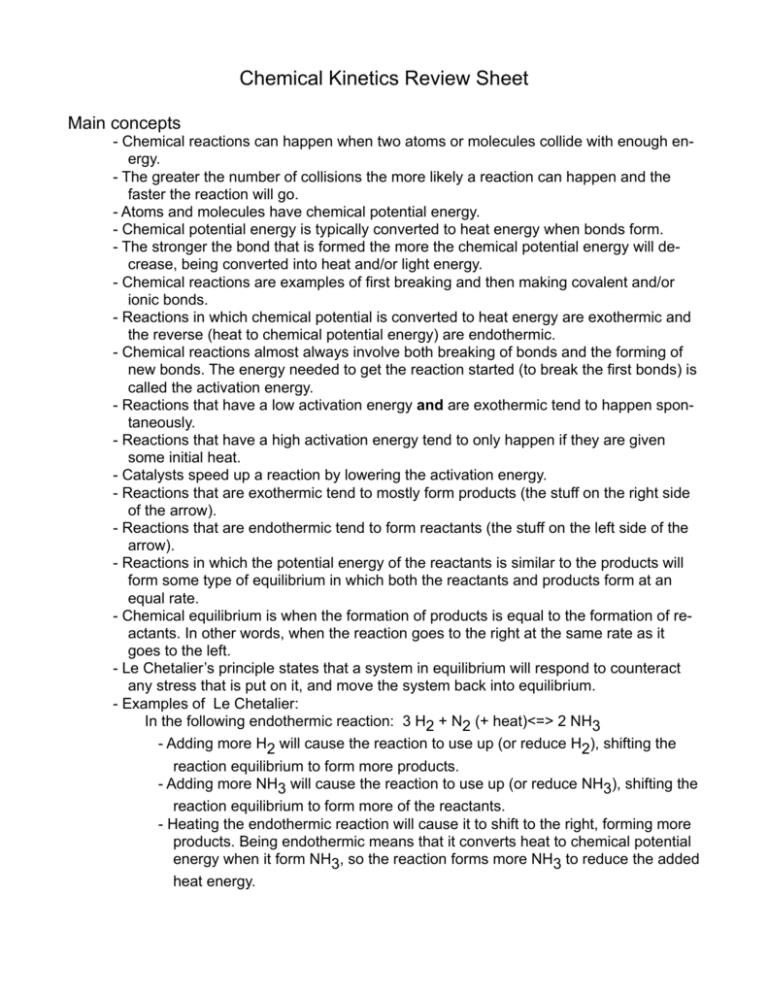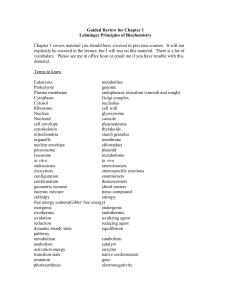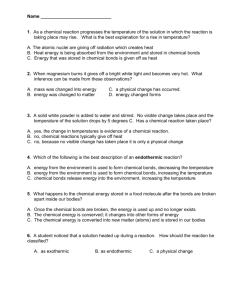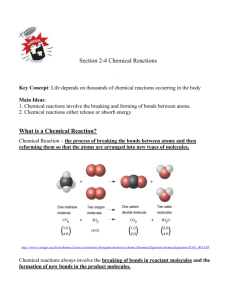Chemical Kinetics Review Sheet
advertisement

Chemical Kinetics Review Sheet Main concepts - Chemical reactions can happen when two atoms or molecules collide with enough energy. - The greater the number of collisions the more likely a reaction can happen and the faster the reaction will go. - Atoms and molecules have chemical potential energy. - Chemical potential energy is typically converted to heat energy when bonds form. - The stronger the bond that is formed the more the chemical potential energy will decrease, being converted into heat and/or light energy. - Chemical reactions are examples of first breaking and then making covalent and/or ionic bonds. - Reactions in which chemical potential is converted to heat energy are exothermic and the reverse (heat to chemical potential energy) are endothermic. - Chemical reactions almost always involve both breaking of bonds and the forming of new bonds. The energy needed to get the reaction started (to break the first bonds) is called the activation energy. - Reactions that have a low activation energy and are exothermic tend to happen spontaneously. - Reactions that have a high activation energy tend to only happen if they are given some initial heat. - Catalysts speed up a reaction by lowering the activation energy. - Reactions that are exothermic tend to mostly form products (the stuff on the right side of the arrow). - Reactions that are endothermic tend to form reactants (the stuff on the left side of the arrow). - Reactions in which the potential energy of the reactants is similar to the products will form some type of equilibrium in which both the reactants and products form at an equal rate. - Chemical equilibrium is when the formation of products is equal to the formation of reactants. In other words, when the reaction goes to the right at the same rate as it goes to the left. - Le Chetalier’s principle states that a system in equilibrium will respond to counteract any stress that is put on it, and move the system back into equilibrium. - Examples of Le Chetalier: In the following endothermic reaction: 3 H2 + N2 (+ heat)<=> 2 NH3 - Adding more H2 will cause the reaction to use up (or reduce H2), shifting the reaction equilibrium to form more products. - Adding more NH3 will cause the reaction to use up (or reduce NH3), shifting the reaction equilibrium to form more of the reactants. - Heating the endothermic reaction will cause it to shift to the right, forming more products. Being endothermic means that it converts heat to chemical potential energy when it form NH3, so the reaction forms more NH3 to reduce the added heat energy. Collision Theory of Reactions - 1) What must happen for two atoms to react with each other? - 2) How does temperature affect reaction rate? Why? - 3) How does the concentration of dissolved substances affect the reaction rate? Why? - 4) How does the surface area of solids involved in a reaction affect the reaction rate? Why? - 5) When the Brooklyn bridge was built people worked underwater in a pressurized chamber to keep the water out. Explain why their lanterns burned much brighter (ie had a faster reaction between the fuel and the oxygen in the air). Chemical Potential Energy - 6) What is chemical potential energy? - 7) When we eat food, the food contains chemical potential energy? Where does this energy go? We eat food every day, so why doesn’t chemical potential energy keep building up in our bodies? - 8) Which has more chemical potential energy two separate atoms or two bonded atoms? - 11) Which has more chemical potential energy a molecule with atoms that are bonded together with very strong covalent bonds or one with atoms that are bonded together with weaker covalent bonds? - 15) When chemical potential energy decreases, to what kinds of energy is it usually converted? - 18) What does endothermic and exothermic mean? Equilibrium - 19) Describe how you know when a chemical reaction reaches equilibrium. - 20) Here is an exothermic reaction: A + B <=> AB (+ heat) a) if this system was in equilibrium what can you say about the concentrations of A, B, and AB? b) What would happen if you stressed the equilibrium by adding more A? c) What would happen if you stressed the equilibrium by cooling it? d) What would happen if these were all gasses and you compressed the system increasing the pressure? - Potential Energy graphs 5. Draw a chemical potential energy diagram for a highly exothermic reaction. 6. Draw a chemical potential energy diagram for an endothermic reaction with a small activation energy. 7. Draw a chemical potential energy diagram of an exothermic reaction with high activation energy. 8. AB and CD are held together by weaker bonds than AC or BD. Draw a chemical potential energy diagram for the reaction of AB + CD => AC + BD 9. AB and CD are held together by stronger bonds than AC or BD. Draw a chemical potential energy diagram for the reaction of AB + CD => AC + BD 10. Draw three chemical potential energy diagrams and consider the fact that B2 is held together by single bonds, C2 is held together by double bonds and D2 is held together by triple bonds: A2 + B2 => 2 AB 2 A2 + C2 => 2 A2C 3 A2 + D2 => 2 DA3 1. Consider the following chemical reaction AB + C <=> A + BC. Draw chemical potential energy diagrams for the reaction according to the following situation a. Equilibrium lies far to the right. b. Equilibrium lies far to the left. c. Equilibrium lies slightly to the right. d. Equilibrium lies slightly to the left. Answers to Questions: 1) They must collide with each other. If two molecules are reacting then they must collide with enough energy (called the activation energy) to break their initial bonds so that new bonds can form. 2) Temperature, in general, increases the reaction rate because the reactants are moving faster, so they hit more often, having more collisions. Each time there is a collision, there is a chance that a reaction can occur, so more collisions means more reactions. 3) Higher concentration means there are more reactant molecules in a certain area, so there will be more collisions, so the reaction will go faster. 4) If there is more surface area then more of the solid’s molecules are exposed to whatever molecules they may be reacting with. That means there will be more collisions, and a faster reaction. 5) The chemical reaction for the lantern is: fuel + oxygen --> combustion products (it doesn’t matter what these are to answer this question). So, if the air is pressurized, then the concentration of oxygen will be greater. That means there will be more collisions between oxygen molecules and fuel molecules, so the reaction will go faster and the lanterns will burn much brighter. 6) The potential to form a bond. Unbonded things have the most chemical potential. Weakly bonded things can easily break those bonds and form stronger bonds, so they have less chemical potential. And strongly bonded things would have a hard time bonding with anything stronger, so they have the least chemical potential. 7) The chemical potential energy is converted to other forms of energy, so it can’t build up in our bodies. The chemical potential energy is converted to heat energy (so we keep a constant temperature), kinetic energy (when we move any part of our body), gravitational potential energy (whenever we climb stairs or hills), and electrical energy (as small electrical currents are generated across the walls of our cells or sent through nerve cells to our brains). 8) Two separate atoms. When they bond they will be attracted to each other and rush toward each other, converting their chemical potential to kinetic/heat energy. 11) The weaker bonded molecule has more chemical potential energy because those bonds can easily break, making it possible for the atoms in that molecule to bond more strongly with other atoms. Explosives work in this way. Atoms are weakly bonded in the explosive, but rearrange to form molecules with very strong bonds during the explosion. The formation of the strong bond converts an enormous amount of chemical potential energy to kinetic/heat energy. 15) It is usually converted to heat and/or light energy. 18) Endothermic means a reaction converts heat to potential, so heat energy is absorbed and things cool down (or stay the same temperature as more heat is added). Exothermic means a reaction converts chemical potential to heat energy, so things warm up (or stay the same temperature if you continually cool the reaction). 19) A reaction reaches chemical equilibrium when the concentration of reactants (stuff on the left side of the arrows) and the concentration of the products (stuff on the right side of the arrows) remains constant. This is due to the fact the the reaction rate from left to right is the same as the rate from right to left. 20) a: They will be constant. b: It will respond to reduce “A” by temporarily increasing the reaction from left to right (forming “AB”) . This happens because the addition of “A” causes a sudden increase in the concentration of “A”, causing more collisions between “A” and “B”. This increases the rate of reaction between “A” and “B”, so the reaction goes from left to right more quickly. Eventually, when the amount of “A” is reduced and the amount of “AB” is increased, equilibrium will be reached again. c: Cooling it means you are reducing the heat energy, so the reaction will go in a way that will produce more heat energy. The formation of “AB” is exothermic which converts potential to heat energy, so the reaction will go from left to right, forming more “AB” and producing more heat, eventually reaching equilibrium once again. d: Increasing the pressure will cause the equilibrium to react in such a way as to reduce the pressure. If you look at the equation you can see that if ALL the “A” and “B” combined to form “AB” then there would be half as many molecules than if all the “AB” broke apart into “A” and “B”. Having less molecules bouncing around would reduce the pressure, so the reaction will go in the direction to produce “AB” which takes two separate molecules and makes one molecule. Eventually, the equilibrium will be reached again. Potential Energy Diagrams: 5) bonds broken and stronger ones formed 6) stronger bonds broken and weaker bonds formed 7) bonds broken and 8) weaker bonds broken much stronger bonds stronger bonds formed formed, but the reaction requires a lot of energy to start 9) stronger bonds broken - weaker bonds formed 10a) single bond needs to be broken to react 10b) Double bond needs to be broken. 10c) Triple bond needs to be broken. 11a) more stable bonds in the products 11b) more stable reactants 11c) slightly more stable products 11d) slightly more stable reactants








